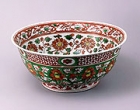Japanese Archaeology and Special Exhibition (Heiseikan) Thematic Exhibition Room
September 9, 2008 (Tue) - October 19, 2008 (Sun)
In Japan there is a custom of preserving precious vessels of lacquer ware, ceramics, etc. in cloth bags, which are put in boxes and then wrapped with cloth. Fabrics used for such bags and wrappers were often imported from China or other Asian countries, and are as valuable as the vessels inside.
Inviting guests and entertaining them with tea and cuisine; planning how to decorate the room according to the season and occasion, and selecting tea bowls and other tea utensils to match - people who enjoyed the tea ceremony must have known these pleasures quite well. That is why they carefully preserved each vessel in their favorite bags or cloth.
This thematic display features imported fabric known as Hikone Sarasa and porcelain from the Jingdezhen non-imperial kiln of China, which were imported to Japan during the Momoyama (1573-1603) and Edo (1603-1868) periods and appreciated by tea masters.
Inviting guests and entertaining them with tea and cuisine; planning how to decorate the room according to the season and occasion, and selecting tea bowls and other tea utensils to match - people who enjoyed the tea ceremony must have known these pleasures quite well. That is why they carefully preserved each vessel in their favorite bags or cloth.
This thematic display features imported fabric known as Hikone Sarasa and porcelain from the Jingdezhen non-imperial kiln of China, which were imported to Japan during the Momoyama (1573-1603) and Edo (1603-1868) periods and appreciated by tea masters.

